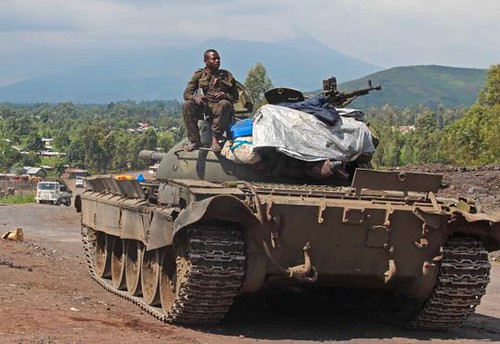
Democratic Republic of Congo soldier sits on an army tank outside the eastern city of Goma on November 19, 2012. The city was reportedly siezed by M23 rebels with very little resistance., a photo by Pan-African News Wire File Photos on Flickr.
Rwanda-Congo deja vu?
By JASON STRAZIUSO
Associated Press
November 20, 2012
NAIROBI, Kenya (AP) — History is repeating itself yet again in eastern Congo. Rebels supported by Rwanda are on the march. Civilians are fleeing. And higher powers appear to be taking sides.
Congo and Rwanda have been at this stage before. First in 1996, then in 1998. Also in 2004 and 2008. The first two conflicts had their roots in Rwanda’s 1994 genocide, but now the fighting is mostly over mineral wealth — including minerals used in the world’s smart phones and laptops.
Congo is rich in diamonds, gold, copper, cobalt and tungsten. The provincial capital of Goma, which lies on the Rwandan border and which fell to the M23 rebel group on Tuesday, is a major processing point for minerals coming out of eastern Congo.
Rwanda insists it is not aiding the M23 rebels, though a U.N. group of experts report written this year said Rwanda and Uganda were doing exactly that.
Many M23 commanders were formerly with the rebel group known as CNDP, which carried out the same military tactics, with Rwanda’s backing, in 2007-08, experts say.
‘‘I'm just getting a sense of deja vu right now,’’ said Carina Tertsakian, a Rwanda researcher for Human Rights Watch, who ticked off the five Congo-Rwanda conflicts. ‘‘On each of those occasions the Rwandan military has actively and significantly supported Congolese rebel groups who were extremely violent and committed very serious crimes against civilians.’’
What do the rebels — and by extension, Rwanda — want?
To acquire political, military and economic control over eastern parts of Congo, Tertsakian says. After peace talks, the rebels can land plum spots in the military and can end up controlling Congo’s rich natural resources. Rwanda transships many of the minerals while taking a cut.
Land may also be at stake. Rwanda’s 10 million people are densely congregated at 980 per square mile compared to Congo’s 60 million, who average 66 per square mile.
Rwanda’s 1996 and 1998 incursions into Congo were driven by Rwanda’s troubled ethnic past. Rwanda justified the invasions on the basis that its security was being threatened by a rebel group called the FDLR, a group of ethnic Hutus. Extremist Hutus killed more than 500,000 Tutsis and moderate Hutus during the country’s 1994 genocide. But the FDLR today is nowhere near as powerful as it once was, and the Hutu threat is not such a concern to Rwandan President Paul Kagame, a Tutsi.
Rwanda has suffered little in the international community for its support of Congolese rebels over the years. Many observers suggest that the West has turned a blind eye because of lingering guilt that it did nothing to stop the 1994 genocide. But criticism is mounting.
Amnesty International said in July that M23 rebels were using Rwandan recruits and weapons supplied by Rwanda. The group documented violations of humanitarian law and human rights abuses, including the forced recruitment of children.
The U.N. group of experts report, which will be released publicly on Friday, spurred a negative international reaction. The U.S. suspended its military aid — albeit only $200,000 — to Rwanda after parts of the preliminary report were leaked. Other European countries followed suit, suspending humanitarian aid to Rwanda.
The International Crisis Group on Tuesday called for sanctions by the U.N., U.S., EU, U.K. and France against the M23’s leader and their ‘‘external supporters.’’
‘‘The past week has shown history repeating itself in eastern Democratic Republic of Congo (DRC), with the same tragic consequences for civilians in the region,’’ the International Crisis Group said.
No comments:
Post a Comment